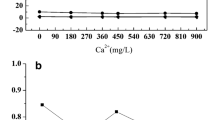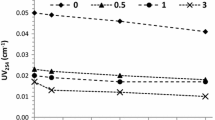Abstract
The ozonation involved in drinking water treatment raises issues of water quality security when the raw water contains bromide (Br−). Br− ions may be converted to bromate (BrO3 −) during ozonation and some brominated disinfection by-products (Br-DBPs) in the following chlorination. In this study, the effects of ozone (O3) dosage, contact time, pH, and Br− and ammonia (NH3-N) concentrations on the formation of BrO3 − and Br-DBPs have been investigated. The results show that decreasing the initial Br− concentration is an effective means of controlling the formation of BrO3 −. When the concentration of Br− was lower than 100 μg/L, by keeping the ratio of O3 dosage to dissolved organic carbon (DOC) concentration at less than 1, BrO3 − production was effectively suppressed. The concentration of BrO3 − steadily increased with increasing O3 dosage at high Br− concentration (>900 μg/L). Additionally, a longer ozonation time increased the concentrations of BrO3 − and total organic bromine (TOBr), while it had less impact on the formation potentials of brominated trihalomethanes (Br-THMFP) and haloacetic acids (Br-HAAFP). Higher pH value and the presence of ammonia may lead to an increase in the formation potential of BrO3 − and Br-DBPs.















Similar content being viewed by others
References
Abdullah MP, Yew CH, Ramli MSB (2003) Formation, modeling and validation of trihalomethanes (THM) in Malaysian drinking water: a case study in the districts of Tampin, Negeri Sembilan and Sabak Bernam, Selangor, Malaysia. Water Res 37:4637–4644
Acero JL, Benitez FJ, Real FJ, Roldan G, Rodriguez E (2013) Chlorination and bromination kinetics of emerging contaminants in aqueous systems. Chem Eng J 219:43–50
Aljundi IH (2011) Bromate formation during ozonation of drinking water: a response surface methodology study. Desalination 277:24–28
Andrews JE, Nichols HP, Schmid JE, Mole LM, Hunter ES III, Klinefelter GR (2004) Developmental toxicity of mixtures: the water disinfection by-products dichloro-, dibromo-and bromochloro acetic acid in rat embryo culture. Reprod Toxicol 19:111–116
Antoniou MG, Andersen HR (2012) Evaluation of pretreatments for inhibiting bromate formation during ozonation. Environ Technol 33:1747–1753
APHA (1998) Standard methods for the examination of water and wastewater, 20th edn. American Public Health Association, Washington, DC
Ates N, Yetis U, Kitis M (2007) Effects of bromide ion and natural organic matter fractions on the formation and speciation of chlorination by-products. J Environ Eng 133:947–954
Bader H, Hoigné J (1981) Determination of ozone in water by the indigo method. Water Res 15:449–456
Bouland S, Duguet J, Montiel A (2004) Minimizing bromate concentration by controlling the ozone reaction time in a full-scale plant. Ozone: Sci Eng 26:381–388
Butler R, Godley A, Lytton L, Cartmell E (2005) Bromate environmental contamination: review of impact and possible treatment. Crit Rev Environ Sci Technol 35:193–217
Chiang P, Chang E, Chang P, Huang C (2009) Effects of pre-ozonation on the removal of THM precursors by coagulation. Sci Total Environ 407:5735–5742
Chow AT, Dahlgren RA, Harrison JA (2007) Watershed sources of disinfection byproduct precursors in the Sacramento and San Joaquin Rivers, California. Environ Sci Technol 41:7645–7652
Chowdhury S, Champagne P, McLellan PJ (2009) Models for predicting disinfection byproduct (DBP) formation in drinking waters: a chronological review. Sci Total Environ 407:4189–4206
Di Cristo C, Esposito G, Leopardi A (2013) Modelling trihalomethanes formation in water supply systems. Environ Technol 34:61–70
Ge F, Shu H, Dai Y (2007) Removal of bromide by aluminium chloride coagulant in the presence of humic acid. J Hazard Mater 147:457–462
Gerrity D, Mayer B, Ryu H, Crittenden J, Abbaszadegan M (2009) A comparison of pilot-scale photocatalysis and enhanced coagulation for disinfection byproduct mitigation. Water Res 43:1597–1610
Haag WR, Hoigne J (1983) Ozonation of bromide-containing waters: kinetics of formation of hypobromous acid and bromate. Environ Sci Technol 17:261–267
Heeb MB, Criquet J, Zimmermann-Steffens SG, von Gunten U (2014) Oxidative treatment of bromide-containing waters: Formation of bromine and its reactions with inorganic and organic compounds—a critical review. Water Res 48:15–42
Hofmann R, Andrews RC (2001) Ammoniacal bromamines: a review of their influence on bromate formation during ozonation. Water Res 35:599–604
Hong HC, Liang Y, Han BP, Mazumder A, Wong MH (2007) Modeling of trihalomethane (THM) formation via chlorination of the water from Dongjiang River (source water for Hong Kong’s drinking water). Sci Total Environ 385:48–54
Johnson CJ, Singer PC (2004) Impact of a magnetic ion exchange resin on ozone demand and bromate formation during drinking water treatment. Water Res 38:3738–3750
Karanfil T, Erdogan I, Schlautman MA (2003) Selecting filter membranes for measuring DOC and UV254. J Am Water Works Assoc 95:86–100
Legube B, Parinet B, Gelinet K, Berne F, Croue J (2004) Modeling of bromate formation by ozonation of surface waters in drinking water treatment. Water Res 38:2185–2195
Li Y, Zhang X, Shang C, Krasner SW (2011) Evaluation and improvement of total organic bromine analysis with respect to reductive property of activated carbon. Water Res 45:1229–1237
Liu W, Cheung L, Yang X, Shang C (2006) THM, HAA and CNCl formation from UV irradiation and chlor(am)ination of selected organic waters. Water Res 40:2033–2043
Lu J, Zhang T, Ma J, Chen Z (2009) Evaluation of disinfection by-products formation during chlorination and chloramination of dissolved natural organic matter fractions isolated from a filtered river water. J Hazard Mater 162:140–145
Maghsoodloo S, Noroozi B, Haghi AK, Sorial GA (2011) Consequence of chitosan treating on the adsorption of humic acid by granular activated carbon. J Hazard Mater 191:380–387
Michałowicz J, Duda W, Stufka-Olczyk J (2007) Transformation of phenol, catechol, guaiacol and syringol exposed to sodium hypochlorite. Chemosphere 66:657–663
Mizuno T, Ohara S, Nishimura F, Tsuno H (2011) O3/H2O2 process for both removal of odorous algal-derived compounds and control of bromate ion formation. Ozone: Sci Eng 33:121–135
Molnar J, Agbaba J, Dalmacija B, Tubić A, Krčmar D, Maletić S, Tomašević D (2013) The effects of matrices and ozone dose on changes in the characteristics of natural organic matter. Chem Eng J 222:435–443
Moslemi M, Davies SH, Masten SJ (2011) Bromate formation in a hybrid ozonation-ceramic membrane filtration system. Water Res 45:5529–5534
Na C, Olson TM (2006) Mechanism and kinetics of cyanogen chloride formation from the chlorination of glycine. Environ Sci Technol 40:1469–1477
Nagano K, Kano H, Arito H, Yamamoto S, Matsushima T (2006) Enhancement of renal carcinogenicity by combined inhalation and oral exposures to chloroform in male rats. J Toxicol Environ Health A 69:1827–1842
Nikolaou AD (2004) Investigation of the formation of chlorination by-products in water rich in bromide and organic matter content. J Environ Sci Health A 39:2835–2853
Nikolaou AD, Golfinopoulos SK, Lekkas TD, Arhonditsis GB (2004) Factors affecting the formation of organic by-products during water chlorination: a bench-scale study. Water Air Soil Poll 159:357–371
Panyapinyopol B, Kanokkantapong V, Marhaba TF, Wattanachira S, Pavasant P (2005) Kinetics of trihalomethane formation from organic contaminants in raw water from the Bangkhen water treatment plant. J Environ Sci Health A 40:1543–1555
Pinkernell U, von Gunten U (2001) Bromate minimization during ozonation: mechanistic considerations. Environ Sci Technol 35:2525–2531
Plewa MJ, Simmons JE, Richardson SD, Wagner ED (2010) Mammalian cell cytotoxicity and genotoxicity of the haloacetic acids, a major class of drinking water disinfection by-products. Environ Mol Mutagen 51:871–878
Qi Y, Shang C, Lo I (2004) Formation of haloacetic acids during monochloramination. Water Res 38:2375–2383
Reckhow DA, Singer PC, Malcolm RL (1990) Chlorination of humic materials: byproduct formation and chemical interpretations. Environ Sci Technol 24:1655–1664
Richardson SD, Postigo C (2012): Drinking water disinfection by-products. Emerg Org Contam Hum Health. Springer, pp. 93–137
Rodrigues PM, Esteves Da Silva JC, Antunes MCG (2007) Factorial analysis of the trihalomethanes formation in water disinfection using chlorine. Anal Chim Acta 595:266–274
Sadiq R, Rodriguez MJ (2004) Fuzzy synthetic evaluation of disinfection by-products—a risk-based indexing system. J Environ Manage 73:1–13
Selcuk H, Vitosoglu Y, Ozaydin S, Bekbolet M (2005) Optimization of ozone and coagulation processes for bromate control in Istanbul drinking waters. Desalination 176:211–217
Siddiqui MS, Amy GL (1993) Factors affecting DBP formation during ozone-bromide reactions. J Am Water Works Assoc 85:63–72
Sohn J, Amy G, Yoon Y (2006) Bromide ion incorporation into brominated disinfection by-products. Water, Air, Soil Pollut 174:265–277
Tian C, Liu R, Guo T, Liu H, Luo Q, Qu J (2013) Chlorination and chloramination of high-bromide natural water: DBPs species transformation. Sep Purif Technol 102:86–93
Tokmak B, Capar G, Dilek FB, Yetis U (2004) Trihalomethanes and associated potential cancer risks in the water supply in Ankara, Turkey. Environ Res 96:345–352
USEPA, 1998. National primary drinking water regulations: disinfection and disinfection byproducts. Federal Reg. 63, 69390e69476
Uyak V, Toroz I (2007) Investigation of bromide ion effects on disinfection by-products formation and speciation in an Istanbul water supply. J Hazard Mater 149:445–451
Villanueva CM, Kogevinas M, Grimalt JO (2003) Haloacetic acids and trihalomethanes in finished drinking waters from heterogeneous sources. Water Res 37:953–958
von Gunten U (2003a) Ozonation of drinking water: part I. Oxidation kinetics and product formation. Water Res 37:1443–67
von Gunten U (2003b) Ozonation of drinking water: Part II. Disinfection and by-product formation in presence of bromide, iodide or chlorine. Water Res 37:1469–1487
von Gunten U, Hoigne J (1994) Bromate formation during ozonization of bromide-containing waters: interaction of ozone and hydroxyl radical reactions. Environ Sci Technol 28:1234–1242
von Gunten U, Oliveras Y (1998) Advanced oxidation of bromide-containing waters: bromate formation mechanisms. Environ Sci Technol 32:63–70
Weber N, Higuchi T, Tessari J, Veeramachaneni DR (2004) Evaluation of the effects of water disinfection by-products, bromochloroacetic and dibromoacetic acids, on frog embryogenesis. J Toxicol Environ Health 67:929–939
Westerhoff P, Song R, Amy G, Minear R (1998) NOM’s role in bromine and bromate formation during ozonation. J Am Water Works Assoc 90:82–94
White DM, Garland DS, Narr J, Woolard CR (2003) Natural organic matter and DBP formation potential in Alaskan water supplies. Water Res 37:939–947
WHO, World Health Organization (2011): Guidelines for drinking-water quality
Yan M, Wang D, Shi B, Wang M, Yan Y (2007) Effect of pre-ozonation on optimized coagulation of a typical North-China source water. Chemosphere 69:1695–1702
Yang X, Shang C (2004) Chlorination byproduct formation in the presence of humic acid, model nitrogenous organic compounds, ammonia, and bromide. Environ Sci Technol 38:4995–5001
Zhang J (2009): Factors influencing formation and control of disinfection by-production during chlorination in drinking water treatment. Master Thesis, Harbin Institute of Technology
Zhao Q, Shang C, Zhang X, Ding G, Yang X (2011) Formation of halogenated organic byproducts during medium-pressure UV and chlorine coexposure of model compounds, NOM and bromide. Water Res 45:6545–6554
Acknowledgments
Financial support was received from the National Natural Science Foundation of China (Project 51378173) and the Funds sponsored by the Qing Lan Project.
Author information
Authors and Affiliations
Corresponding author
Additional information
Responsible editor: Ester Heath
Rights and permissions
About this article
Cite this article
Lin, T., Wu, S. & Chen, W. Formation potentials of bromate and brominated disinfection by-products in bromide-containing water by ozonation. Environ Sci Pollut Res 21, 13987–14003 (2014). https://doi.org/10.1007/s11356-014-3329-2
Received:
Accepted:
Published:
Issue Date:
DOI: https://doi.org/10.1007/s11356-014-3329-2




